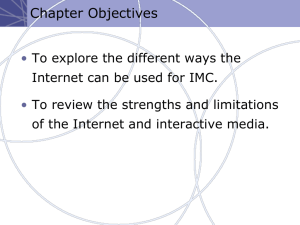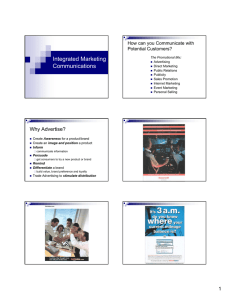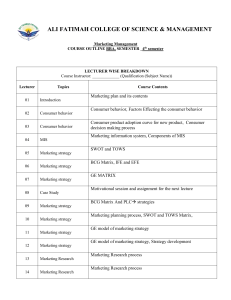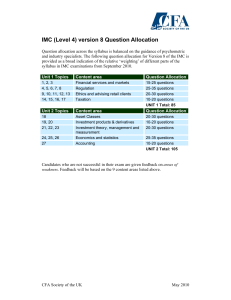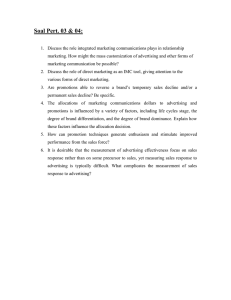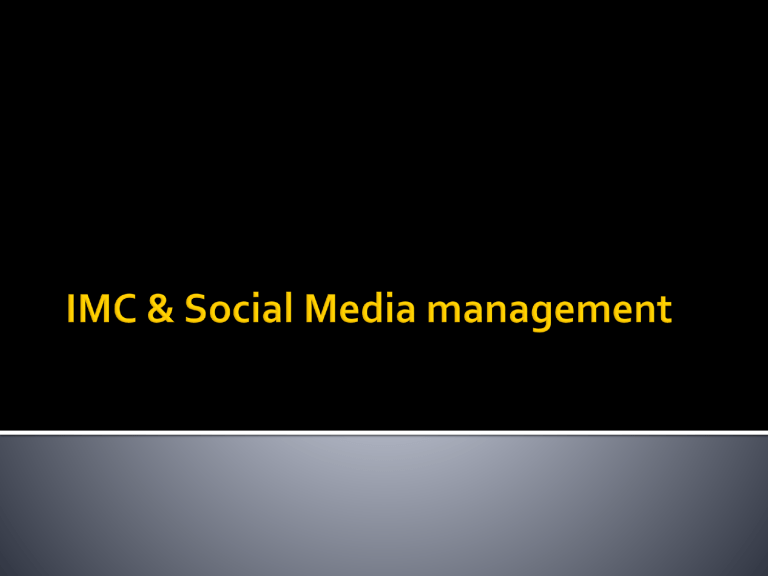
List the first 3 E-commerce companies that come to mind. • • • Describe the advertisements used by each. Can you identify each company’s logo, tagline or any other prominent identification marks? What makes a good E-commerce advertisement? Discussion Slide 1-2 Integrated Marketing Communications • Highly competitive global marketplace. • Need to invest marketing dollars wisely. • Firms are demanding accountability. • Change in roles of account executives, creatives and brand managers. • Chapter One topics: • Communication processes • Integrated marketing communications • Global integrated marketing communications 1-3 Communication Process 1-4 STOP • • • • INTEGRATED LEARNING EXPERIENCE Reebok (http://www.reebok.com) New Balance (http://www.newbalance.com) Asics (http://www.asicstiger.com) Skechers (http://www.skechers.com) 1-5 Barriers to Communication Between Individuals • • • • • Age Gender Culture Social status Personality Between Companies • Poor selling techniques Unfocused advertising Poor media choices (Ad of prothom • Failure to find correct contact persons • • alo at feature page) Within Companies • • • • • Poor downward flow (orders, procedures) Poor lateral flow (communication between departments) Poor upward flow (employees afraid of management) Poor machinery (computers, telephone systems, intranet systems) Information not stored for future use or poor retrieval system 1-6 Discussion Slide • To how many ads were you exposed during the last 24 hours from the following media? Television Radio Magazines Newspapers Billboards Internet Web sites • How many ads can you recall from each of the above media? (Class work) • We need to Avoid clutter…… 1-7 Integrated Marketing Communications is the coordination and integration of all marketing communication tools, avenues and sources within a company into a seamless program which maximizes the impact on consumers and other end-users at a minimal cost. The IMC includes: a) business-to-business, b) channel customer c) external communications and internal communications. 1-8 • • • • • • Situation analysis. Marketing objectives. Marketing budget. Marketing strategy. Marketing tactics. Evaluation 1-9 • • • • • • • • • • • • Company logo Product brand name and company name Business cards Letterhead Carry home bags (paper or plastic) Wrapping paper Coupons Promotional giveaways (coffee mugs, pens, pencils, calendars) Design of booth for trade shows Advertisements (billboards, space used on cars and busses, television, radio, magazines and newspapers) Toll free sample number Company database • • • • • • • • • • • Cooperative advertising with other businesses Personal selling Characteristics of target market buyers Characteristics of business buyers Sales incentives provided to sales force (contests, prizes, bonuses and commissions) Internal messages Company magazines and newspapers Statements to shareholders Speeches by company leaders Public relations releases Sponsorship programs 1-10 [American Productivity & Quality Center] Stage 1: Identify, coordinate and manage all forms of external communications. Stage 2: Extend the scope of communication to include everyone in the organization. Stage 3: Apply information technologies to the IMC program. Stage 4: Treat the IMC as an investment and not a departmental function. 1-11 Factors Affecting the Value of IMC Programs • • • • • • • Development of information technology. Changes in channel power. Increase in competition (global competitors) Maturing markets. Brand parity Integration of information by consumers Decline in effectiveness of mass media advertising. 1-12 Changes in Channel Power Greater use of the Internet to buy and sell products drastic decline in mass media Master card for Single mother 1-13 Viewer Activities During TV Commercials Positive Responses: Get amused by the ads (26%) Sit and watch commercials (19%) • • Negative Responses: • • • • • • • Get annoyed at the number of ads (52%) Get up and do something else (45%) Switch channels (39%) Talk to others in the room (34%) Turn down the sound on TV (19%) Read (11%) Use the computer (5%) Source: Jennifer Lach, “Commercial Overload,” American Demographics, (September 1999), Vol.. 21, No. 9, p. 20. 1-14 • • Goal is to build an IMC campaign. From each chapter, concepts learned will be applied to your IMC Campaign. • Select your IMC team. • Choose a good or service for IMC project: • Covid Commerce and Communication 1-15 • People - They are target of marketing What are people from a marketing perspective? – They have a mind, a body, a spirit – Complex System of Organs – Marketing Organ Systems- Brain, Eyes, Ears and Heart – People also have beliefs, emotions feelings, thoughts (past) and thinking (present) Knowledge • • • Emotion Mental = Brain (Thoughts) Emotional = Heart (Feelings) Intuitive = Gut (Beliefs) The Brain Looks at Product and Services Through This Lens. That’s why Marketer's Need to Know This People • People are not just the consumers but are the entire value chain partners. They ensure smooth process flow only under strict winwin model. The focus is on customer consciousness to assess common customer insights for ensuring customer care. Positioning • From segmentation to clicking the consumers mind the heart and the spirit to enhance the market share through the branding process Packaging • The focus is on the presentation that is how the product carries itself Promotion • Successful and effective communication is the intent of the organization and is the focal point of promotion. Public Relations • This is an addition marketing mix dimension considered for IMC strategy to ensure customer connectivity Marketing and IMC Process Model Opportunity analysis Competitive analysis Identifying markets Market segmentation Target marketing Marketing Macromarketing analysis Selecting a target market Positioning through marketing strategies Product Decisions decisions Pricing Decisions decisions Channel-ofChanneldistribution ofdistribution Decisions decisions Services Decisions Promotional Decisions Promotional • Advertising decisions • Direct • Advertising marketing • Direct • Interactive marketing marketing • Interactive • Sales marketing promotion • Sales • Publicity promotion and public • Publicity relations and public • Personal relations selling • Personal • Packaging selling • Social alternates Societal Decisions Source: Belch & Belch (2007) Media Management Promotion to final buyer Internet/ Interactive Promotion to trade Resellers Purchase Ultimate consumer • Consumers Ultimate consumer • Businesses •• Consumers Stake • holders Businesses • Value chain partners 10 measure of IMC success 1. 2. 3. 4. 5. 6. 7. 8. 9. 10. Customer Care Mind Share Heart Share Market Share Spirit Share Price Elasticity Corporate Image Brand Equity CSR measure Category Clustering Purpose of Communication • • • • • • • • • • Develop brand awareness Increase category demand Change customer belief or attitude Enhance purchase actions Encourage repeat purchases Build customer traffic Enhance firm image Increase market share Increase sales Reinforce purchase decisions Creative Elements And The Hierarchy Of Effects Model ATTENTION INTEREST DESIRE ACTION headlines, visuals subheads, lead paragraph body copy, boxes, supporting visuals closing paragraph, logo/slogan, tagline, addresses, contact number, etc The Loyalty Pyramid Model Committed buyer Like the brand-considers it a friend Satisfied buyer with switching costs Satisfied/habitual buyer who has no reason to change Switchers/price sensitive - indifferent-no brand loyalty General Guideline of Marketing Communication Be Analytical Be Curious Be Single Minded Be Integrative Be Creative Be Observant Be Patient Be Realistic = ROI Tasks of Communication mix Advertising :The Awareness Builder. Public Relations: the Credibility Builder Sales Promotion: Intensifying Consideration Direct Response And Personal Sales: The Personal Connection Events, Sponsorship, And Customer Service: Experimental Contact Social Communication: social interaction at informal and formal level through media Factors Affecting Communication Mix Nature of Product Stage in PLC Target Market Factors Factors Type of Buying Decision Affecting Choice of Promotion Funds Communication Mix Push or Pull Strategy Sales ($) PLC and Communication Mix Maturity Introduction Growth Decline Time Light Advertising, preintroduction Publicity Heavy use of advertising, PR for awareness; sales promotion for trial Advertising, PR, Brand loyalty Personal Selling for distribution Ads decrease. Sales Promotion, Personal Selling Reminder & Persuasive AD/PR decrease Limited Sales Promotion, Personal Selling for distribution In the late 1800s, both Emile Durkheim and Ferdinand Tönnies conceptualized the idea of social networks in their theories and research of SOCIAL GROUPS. Tönnies argued that social groups can exist as personal and direct social ties linking individuals who share values and belief resulting in community or impersonal, formal, and active social links resulting in society. Durkheim gave a non-individualistic explanation of social facts arguing that social phenomena arise when interacting individuals constitute a reality that can no longer portray properties of individual actors but displays combined property of the group or cluster. Jacob L Moreno is credited with developing the first Sociogram in the 1930s resulting in birth of the concept INTERPERSONAL RELATIONSHIPS. A Sociogram is a graphic representation of social links that a person has. It is a graph drawing that plots the structure of interpersonal relations in a group situation. A Sociogram can be drawn on the basis of many different criteria: Social relations, channels of influence, lines of communication etc. Creation of Social Clusters Those points on a sociogram who have many choices are called Stars. Those with few or no choices are called isolates. However, even isolates could form sociograms In general, social networks are self organizing, emergent, and complex Globally coherent pattern appears from the local interaction of the elements that make up the system. These patterns become more apparent as network size increases. However, a global network analysis of, of all interpersonal relationships in the world is not feasible and is likely to contain so much information as to be uninformative. Concept of Social Media It is a discipline and a methodology for developing a reputation and brand within social media communities, and cultivating influence among potential customers, fans, and supporters Social Media IS NOT A fad A replacement for traditional advertising The first step The magic bullet FREE All about YOU Social Media IS A big deal Going where your customers already are or where they want to be Applicable to most companies in some way or another Time-consuming All about THEM • Global Population 7.395 Billion 3.419 Billion • Internet Users 2.307 Billion • Unique Mobile Users 2.307 Billion • Active Social Media Users • Active Mobile Social Users 1.968 Billion Table 1: Major Social Network Platforms Platform Global Rank Major Age Group Bangladesh Rank Major Age Group Purpose of Use Facebook 1st 16-44 1st 16-54 Social communication Google+ 3rd 16-54 9th 25-54 Crowd creation Whatsapp 10th 16-34 4th 25-34 Personal communication LinkedIn 5th 16-54 6th 25-54 Professional communication Twitter 4th 16-44 7th 16-34 Social messaging Blogg 8th 16-34 10th 16-24 Collaboration Instagram 7th 16-34 11th 25-34 Photo & video sharing Viber 9th 16-44 2nd 16-54 Audio communication YouTube 2nd 16-54 3rd 16-44 Content sharing Skype 11th 16-54 8th 25-54 Conference communication Web Page 6th 16-54 5th 25-54 Institutional communication Global Penetration of internet 2012: 5% Global penetration of internet 2016: 46% Mobile phone in households of Bangladesh: 95% Bangladesh growth of smart phones 2013-16: 35% 100+% smart phone usage Bangladesh: 2021 What role should it play in your marketing? Provide an identity to who we are and the products or services that we offer. Create relationships using social media with people who might not otherwise know about our products or service or what our companies represent. Share personality with them. Associate with peers, that may be serving the same target market. Communicate and provide the interaction that consumers look for. Provides contents which can be used during communication strategy How can it relate to the overall marketing mix? Social media carries a lot of value, we can learn to do it right? Must integrate it with other vehicles of marketing. While social media will create awareness, in the beginning it will not sell worth million. There are no written "right" or "wrong" rules when it comes to social media, only you can determine what will work for a specific company. Be consistent, if one does not plan on being consistent don't do it at all - it's a waste of everyone's time. How is it used at present? Considered as the Big Data Build product and brand awareness Develop and nurture relationships Maintain and enhance reputation Increase traffic to a website Create buzz about a company, product, or person Learn what customers, fans, and supporters want Generate leads Connect people to offline events Comments on use of Social Network (Big) data While one can get a general sense of what is being said about a marketing variable using real time psychographic analytics on the social media posts, or by extracting data from a customer database, a focused marketing goal cannot be clearly addressed using data harvesting methods. Comments on use of Social Network (Big) data (Continued) It is evident that together, Big Data and traditional marketing research data represent a formidable data base in the hands of those who know how and when to exploit both to their full potential. Integrated marketing communications …the whole is greater than the sum of the parts Show Successful Communications
